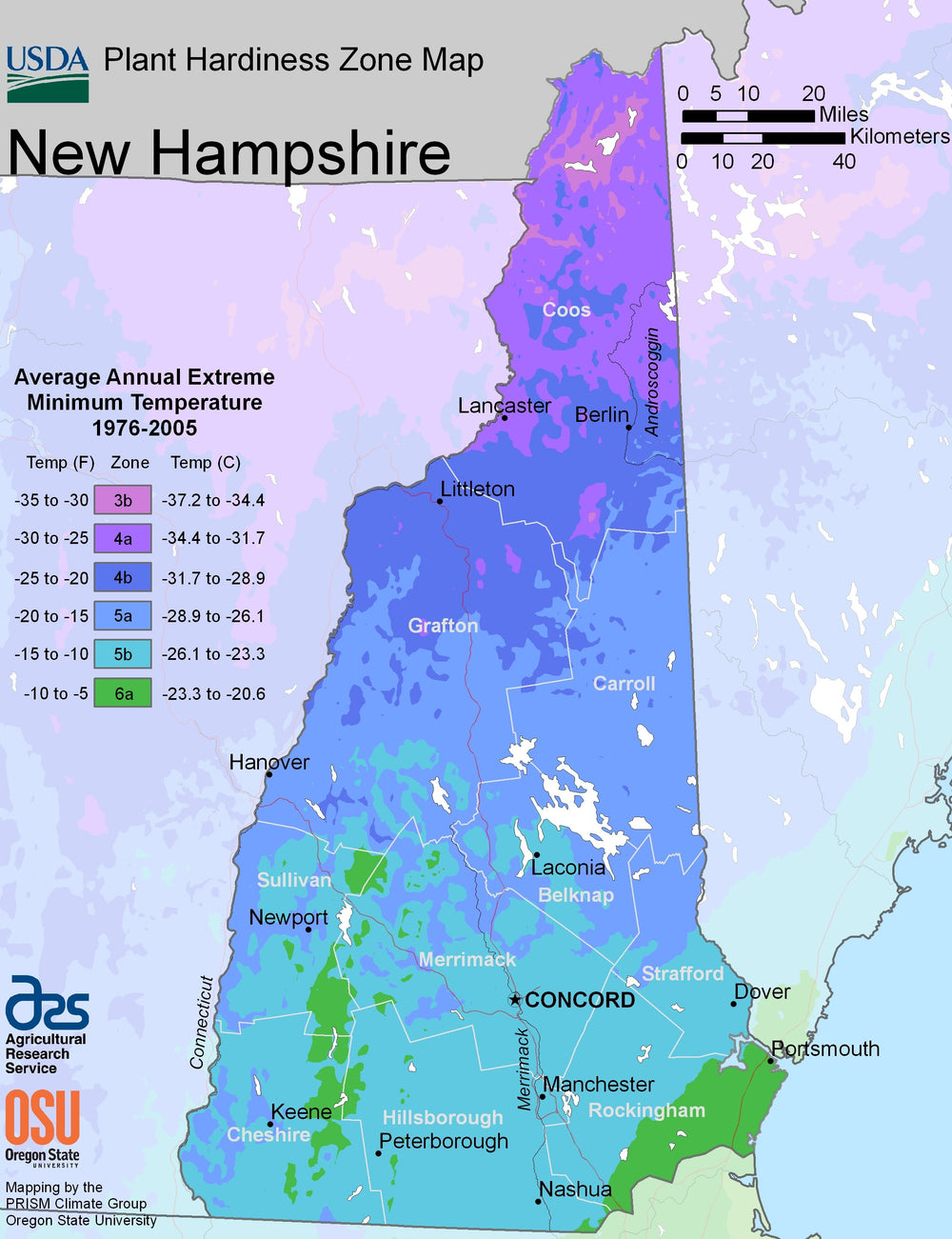Image from USDA
Characteristics of New Hampshire Planting Region
New Hampshire has a humid continental climate, characterized by harsh, snowy winters and mild, humid summers. Much of the state experiences heavy rainfall throughout the year and abundant snowfall. New Hampshire also has its fair share of extreme weather conditions such as:
- Severe thunderstorms
- Floods
- Blizzards
- Ice storms
- Arctic cold fronts
- Coastal storms
- Wildfires
- Landslides
Despite how far north New Hampshire is located, the growing season is slightly longer than some of its neighbouring states. On average, the frost-free period will begin in early May and end around the start of October, with about 149 days between frosts.

Challenges of Growing in New Hampshire
1. Extreme Weather Conditions
Blizzards, severe thunderstorms, wildfires, and more all pose difficulties when it comes to growing a successful garden. The main way to minimize the potential damage extreme weather can have on your plants is to utilize a protective covering to keep them safe.
2. Flooding
New Hampshire is prone to flooding across both coastal and inland parts of the state. It’s suggested to use a combination of both indoor/protected growing and raised garden beds to keep your plants out of harm’s way.
3. Heavy Snowfall
The abundance of snowfall across the region may limit your opportunity to extend your growing season into the winter months. Indoor or protected planting is recommended to make the most out of your garden throughout the year.

The Benefits of Using a Greenhouse in New Hampshire
Greenhouse growing is an excellent option for the climate in New Hampshire. It will protect your garden from the extreme weather conditions across the state and allow you to extend your growing season well into the winter months. A greenhouse will also offer your garden safety and stability, allowing your plants to flourish.
1. Extend your Growing Season
-
Without a Greenhouse:
The average outdoor growing season in New Hampshire ranges between 3-4 months across the state. Many gardeners need to sprout their seeds indoors and transplant them in their garden later to avoid more tender vegetables being damaged by frosts.
-
With a Greenhouse:
Greenhouses have been a popular option to extend the growing season in New Hampshire for several decades. Gardeners can expect a 7-10 month of extended planting timeframe, enjoying fresh vegetables well into winter.
Learn more about specific growing dates for your area and the best vegetables to plant in each part of New Hampshire.


Customer images of the Sungrow Greenhouse in New Hampshire
2. Grow a Wider Variety of Vegetables
-
Without a Greenhouse:
To avoid the disappointment of damaged crops from early or late frosts, cold-season vegetables are suggested for outdoor growing across the region. Some popular options include:
- Peas
- Lettuce
- Spinach
- Kale
- Cabbage
- Radishes
- Arugula
-
Turnips
-
With a Greenhouse:
Enjoy a much wider variety of vegetables for your garden by using a greenhouse. New Hampshirites can plant any of the following vegetables without the need to transplant outdoors later.
- Artichokes
- Carrots
- Cucumbers
- Asparagus
- Pumpkins
- Winter Squash
- Cantaloupe
- Eggplant
- Tomatoes
- Peppers
- Lima Beans
- Basil
- Summer Squash
- Sweet Corn
- Zucchini
- Green Beans
- Garlic
- Tomatillos
- Leeks
- Celery
- Spanish Onion
- Jalapeño
- Poblano Peppers

Why Planta Greenhouses?
- Wind resistant up to 65 mph (learn more about how our greenhouses hold up in high-altitude climates).
- Withstands a snow load of up to 98 psf (480kg/square meter).
- Made with a heavy-duty galvanized steel frame.
- Polycarbonate panels provide 100% protection against UV rays.
- The Sungrow greenhouse is bell-shaped - allows the wind, snow, and hail to slide off the sides.
- Extendable (Sungrow, Sigma and Farmer models can be extended beyond 100ft)
- Made in Europe and are exclusively imported
- Maintenance-free

